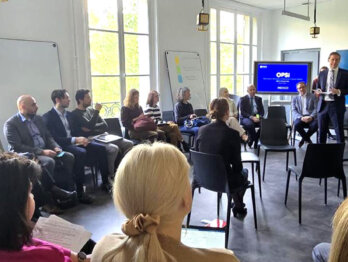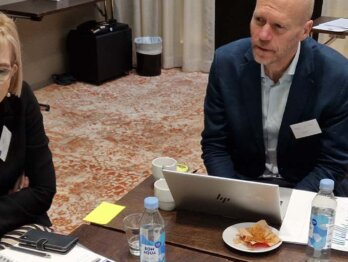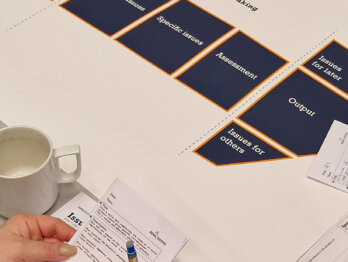Reflections on five years at OPSI

After an amazing and intensive five years with the team at OPSI, I’m leaving the OECD to move on to new adventures back in Australia. Before I go, and with the indulgence of my colleagues, I’d like to take this chance to reflect on some of what I’ve been lucky enough to learn. After all, a big part of innovation is learning, and while it’s very easy in these tumultuous and fast-moving times to not take the time to consider the lessons, we should always strive to do so.
Some milestones in the last five years
One of the first things that strikes me is just how fast the last five years has flown – part of that is no doubt part of getting older (where does the time go?), but I think it is also down to the fact that OPSI has been one of the most high performing and productive teams I’ve ever been part of. It has been fantastic to get to work with colleagues who are open to doing things differently, who come from different backgrounds, cultures and contexts, and who bring different experiences and disciplines to bear. It has also been a great personal pleasure to work and interact with people – not just in OPSI and the OECD more generally but across the world – who are passionate about how government can be, and should be, better.
Whether it be our work with the European Commission through our Horizon 2020 work, our trends work done with the UAE, or individual country projects or our events and being able to respond quickly to the crisis of last year, OPSI has been a dynamic and inspiring place to work. Some of the things I think are important to note include the following:
- Alongside the many reports for which the OECD is renowned, there has been the adherence by over 40 countries to the OECD Declaration on Public Sector Innovation, an important milestone in codifying and signalling the importance that public sector innovation plays and the necessity of governments not only taking it seriously, but approaching it in a systemic, deliberate and explicit manner.
- The global community interested in informing, participating in and shaping the work of OPSI has grown in leaps and bounds. So much of what we do at OPSI relies upon the active contributions of that community, and we could not have achieved much of what we have without the willingness of practitioners, leaders and officials to share.
- The collection of cases and the associated trends work has been so important and also one of the most enjoyable bits of working at OPSI. Seeing the great examples from around the world, meeting the people behind them and considering the implications has been a personal favourite, and I’d like to especially recognise the important work of Jamie Berryhill in making this happen. Our associated work on innovation primers has also been an enlightening process of exploring the potential implications of new approaches and technologies for government, and I want to note the great work of my colleague James Mohun in getting the Rules as Code primer to reality, something that was no easy task.
- The ambitious feat of GovAfterShock last year, which was an experiment for a very uncertain 2020, but also a prototype of a different way of thinking and working for the OECD. It showed us that there was the possibility of different ways of convening, of sharing and of different ways of collecting ‘data’ and gaining insight into what was happening around the world. (I’d like to give special thanks here to my colleagues Kent Aitken, Sam Nutt and especially Heather Buisman for making this wild idea become a reality in the midst of a very trying and challenging year).
- The last year has also been a steep but rich learning curve in online workshops, meetings and engagement with people around the world. While this has been very much a team learning effort, I would like to especially note the contribution of my colleague Angela Hanson as workshop maestro and adapting to virtual facilitation so adeptly and intelligently.
- I think we have also made some important strides in helping formalise and make more rigorous the thinking and guidance around public sector innovation, whether it be through our innovation determinants framework, the innovation facets model (a big nod to the excellent work, thinking and mutual challenging of Piret Tõnurist in bringing that to fruition) or the collection and curation of the Toolkit Navigator (a true example of the value of the OECD and its ability to serve as a collective platform for shared learning and knowledge, and a fantastic achievement in particular by Angela Hanson).
Every day brought something new, and I’d like to give a special thanks and recognition to the head of OPSI, Marco Daglio for his leadership and his openness (and sometimes great patience!) with sticking by some ideas that might have initially seemed a bit crazy or confused. While primarily a team studying, researching and advising on innovation, we have also been a team that has done innovation, and that is never an easy (or particularly comfortable) thing to lead.
I note these things not in order to ‘blow our own horn’ but to note some of what has been perhaps the most intellectually stimulating, challenging and rich period of my life, and to set the scene for some reflections that I hope might be of interest to others.
Insights, musings and reflections
The following is by no means exhaustive or perhaps even particularly surprising, but they are some things I will take away with me.
- Innovation exposes our assumptions and defaults: When you look at things differently and put forward new ideas, it can raise questions about things that previously might have been considered settled. For instance, when we were writing the primer on Rules as Code, this new way of thinking about legislation and rulemaking brought up a lot of conversations about what really are rules, what is really meant by prescriptive legislation, and how rulemaking fits into the workings of government. While these are fundamental to the public sector, a new idea brings new interpretations or new ways of looking at existing things, thereby forcing people to revisit definitions and understandings of how or where things fit. Many things can be presumed to have a shared, common and deep understanding until a new approach forces a reassessment of what core concepts might mean or what the purpose or place of routine practices might actually be. Yet this is not always easy, and many times we might prefer to not revisit things we hoped were accepted. It is important to be prepared for this, and to appreciate the resistance that might come, and accept the messiness that might follow.
- The importance of a good origin story: Like any successful superhero franchise, the widespread adoption of an innovation so often depends upon having a good origin story. It is not enough to have a good idea, or for it to meet a need, or for it to have patronage. We live in complex, messy and crowded times, and a good idea needs to have a good story about it.[1] Any innovative idea will come up against resistance (personal challenges for the superhero), learning curves (coming to grips with superpowers, including their limits), and opposition (the supervillains… ok, that’s a bit of an unfair simile for public sector innovation but you see where I’m going with this). An idea that changes more than just isolated projects or activities is one that provides a story of hope, of inspiration and of inevitability, even when we might know in reality that such stories are messier than that.
- Innovation often has an uncomfortable relationship with the ‘truth’: On a related note, as anyone who has been involved in proposing or selling an innovative proposal to others knows, there is often an uncomfortable element of deceit with innovation. Whether it be lying to yourself (“It won’t take that long/be that hard/involve that many stakeholders” or “I can’t possibly see how it would need to concern x, y and z approvals or why anyone would not like this amazing idea”), not providing the whole truth to others (“Yes I’m 100% confident I’ve thought through everything”, “I’ve seen this work perfectly somewhere else”, “Trust me, it will work”) or being forced to provide certainty about things you cannot possibly be certain about (“We will meet all of the milestones on time (even though we’ve never done this before)”, “This is how much money, resources and support we will need exactly”, “This is the risk profile of this activity, there are no other risks that will happen”) … Innovation is a process of learning, discovery and uncertainty. Yet public sector, bureaucratic and accountability processes seek and reward the known, the expected and the certain. For innovation to occur, then, either someone has to be more certain (or naïve) than they should be or a decision maker has to be more tolerant and permissive than they are generally encouraged to be. An environment that encourages ‘no surprises’ but that also expects innovative activity is one that is hard to square. Until this is reconciled, innovation will involve some degree of sophistry, creativity and/or bravery.
- We all need to get better at talking about different styles of working: One of the greatest contributions our innovation facets model has made for me is to push me to think more about the different ways of working, of thinking, or relating and of supporting that come with different aims and goals. If you’re trying to achieve a big audacious goal (mission-oriented innovation) then it’s going to look different, and require different forms of support, leadership and resourcing, than if you’re trying to better engage with the realities of citizen needs on the ground (adaptive innovation). If you’re trying to understand and engage with weak signals about what the future might look like (anticipatory innovation) then you’re going to have trouble talking and working with people focused on working to improve upon the efficient and effective delivery of existing services with new approaches (enhancement-oriented innovation). A big part of the value of the facets model is providing a more sophisticated way about recognising and talking about different aims, and providing a schema to help people achieve richer and more constructive conversations sooner about what the shared aims are and what their achievement will entail. Yet so many of government processes and working styles still tend to favour one or two particular styles over others. We all need to get better at expanding our appreciation of the different styles if we are to work towards a more complete portfolio of activity that will better prepare us for an increasingly wild and uncertain range of futures. (And I note that the team will have something further on this later this year, so keep an eye out!.)
- 2020 was perhaps the most powerful illustration of why public sector innovation matters: In the innovation game it is always good to be able to point to tangible examples that resonate with peoples experience, to help make this fuzzy ambiguous concept meaningful and real. Well, the COVID-19 pandemic gave us a brutal and blatant demonstration of how and why government matters, but also why its ability to respond with novel solutions is fundamental to its effectiveness. Why does public sector innovation matter? The example of the COVID-19 pandemic and crisis gives us an answer to that. What is the risk of not building innovative capabilities? Again, COVID-19 gives us a clear answer for that. What are the limitations of relying upon crisis or forced necessity for driving innovative responses? Well, COVID-19 gives us an answer for that too. We produced a policy brief with some of the lessons and GovAfterShock was an attempt to help collectively distil some of the key insights and implications, along with many others who have been reckoning with the question of ‘what does it all mean?’ Yet humans are incredibly good at habituating. One of the biggest revelations for me from working with different countries was seeing similar levels of concern about risk despite sometimes radically different risk environments. We get used to things over time, such that a high cost to risk can become habituated to, just as a relatively low cost of risk can begin to seem high if you do not see any evidence to the contrary. We are already collectively habituating to elements of the pandemic and its potency, as an example or as a driver or inspiration for why innovation matters, is starting to fade as well. There is a real risk that we are dependent upon crises to force the changes needed, because the lure of the status quo is so powerful.
- Progress in public sector innovation is currently highly (overly) dependent upon luck: Unsurprisingly then, in working with different countries we have seen many ups and downs in the public sector innovation journey. While we hope and believe that the overall direction is towards a more consistent and cohesive approach to public sector innovation, that does not mean there have not been agendas or movements that have pulled back from fully engaging with innovation in different contexts. As discussed previously, there are many vanguards that set the path only for them to pull back, while serving as exemplars or pathfinders in other jurisdictions. No matter how good an innovative venture within the public sector might be, it is ultimately tied to factors beyond its control – e.g., political developments, changes in senior leadership, unexpected outcomes, stakeholder reactions, etc. – such that it is not enough to place hope or faith in individual projects. Innovation must be seen at a system-wide level, as the uncertainty of any one project is too great to rely on. This is part of why we advocate for a portfolio and a stewardship approach. If the practice of innovation is to succeed, it must be embedded – if not entrenched – such that it is not dependent on individual leaders, individual projects or the winds of fortune. If the public sector is to become proficient, sophisticated and mature in its approach to innovation then it needs to treat innovation as it would any other essential endeavour – with a strategic approach, with endemic training and associated performance expectations, with resourcing tailored to the iterative and exploratory nature of innovation projects, and with accountability mechanisms that equally balance the risks of the status quo with the risks of the promising but unknown. I think it is fair to say that we collectively still have a way to go in this regard.
- While there are a lot of stops and starts, a bigger, more collaborative view is necessary: Until public sector innovation is treated as an embedded and entrenched practice, a collaborative cross-jurisdictional approach is crucial. If progress comes in stops and starts, with some success over there and then over there, then the overall forward momentum is dependent upon linking those parts together. It is too much to ask of people involved with innovative projects in the public sector that end up winding up for them to then safeguard and spread the resultant lessons. This is part of why I believe the work of OPSI is so important, in collecting and curating case studies and connections across jurisdictions, of distilling lessons and insights from diffuse pockets of innovation. Along with academics and others interested in cross-jurisdictional learning, this work matters in helping ensuring that the overall system learning continues, in the hope of avoiding continual reinventing and relearning.
- Learning in the open is so very valuable: I have been in the fortunate position where I have been able to work in the open for over 10 years, with over two hundred blog posts published as a public servant. Not only has this been a personally valuable practice for helping me refine and (hopefully) improve my writing for different audiences, it has more importantly helped me share lessons from my work in real time, test new ideas and thinking, and connect with people across the globe who have lessons and capabilities that have been incredibly useful. It has also allowed me to share lessons with others and help them along in their own journeys. While it is not always easy or possible within the public sector, sharing experiences and lessons helps us all and speeds along the collective learning. OPSI has worked hard to serve as a platform for others to do so, whether it be sharing their case studies, their lessons and experiences with different toolkits and methodologies, or connecting with others to learn about emergent approaches such as anticipatory innovation governance, portfolio management or innovation trends. If you have something to share, perhaps consider doing it through OPSI.
- Innovation is about the intersection of different forces: Once upon a time, a long time ago, when I first started getting involved with public sector innovation, I thought the thing that ultimately mattered was whether an idea was good, and/or whether it was the right answer. Over time I learned that there are many ideas, and many competing ideas of what is good, and that being ‘right’ is rarely enough. With some years of experience in navigating bureaucracy, shepherding innovative ideas through obstacle courses, and learning from so many others about their own experience with innovative projects, I am now much more appreciative of the forces involved. The metaphor I land on is that of physics and inertia. The activity of the public sector has a great deal of inertia, in that it will continue on as is until acted upon by an external force. Often that external force is politics, though that may only slightly alter the direction or affect the degree of momentum. A crisis, such as the COVID-19 pandemic, offers a violent external force which can disrupt the inertia, causing a sudden change in acceleration or direction. And sometimes it comes down to the force of individuals – the psychic force of some combination of sheer stubbornness, determination, charisma, a new way of thinking – that can nudge, or sometimes change the inertia of the bureaucracy. Equally there are many competing forces that can act to maintain the inertia – processes, incumbent interests, resistance and friction – that either deflect the external forces or simply add such mass that the inertia is unchanged by the minor collision of a new idea, no matter how promising. While this is an imperfect metaphor in that these forces can change suddenly (a switch in political positioning for instance can change the balance of forces dramatically and instantly), it has also been a helpful one for me in thinking about the array of factors that need to be considered in thinking about the likely journey of an innovative endeavour or new idea. Others have preferred the metaphor of wayfinding, and navigating through changing winds and waters knowing that there is no perfect map. Regardless of your preferred comparison, I find these parallels helpful for thinking about innovation more systemically.
- The most important thing is to just give it a go: Innovation is never going to be easy, but the aim of the work of OPSI and many others is to help make it less difficult. Because innovation is about learning, about doing things that have not been done before, there will always be more to learn about how to do it. Therefore it means the most important thing is to just get started, as that is the fastest way to learn and get better at it. And in today’s world there is no shortage of areas where the public sector needs to do things differently, to rethink and reassess given a continually changing context. While we should never assume what we have is broken, nor can we assume that it is still suited to a different context. So what are you waiting for?
A final thanks
There are literally hundreds of people who I have learnt from over the past five years and who taught, challenged, inspired or encouraged me during my time at OPSI. While public sector innovation is a continually challenging – sometimes daunting, sometimes amazing – field, the best part of it however is the generous spirit of sharing that I have encountered in so many countries. There are so many people out there determined to help make government be and do better. Whilst perhaps cliché, that is perhaps my greatest reflection – even when things seem hardest we are not alone in this great adventure of transforming the public sector.
I will of course be continuing to follow the great work of my colleagues at OPSI and the rest of the OECD’s Public Governance Directorate, and I hope to contribute as I can into the future. For those who would like to keep in touch, you can find me at @CaptainInnovate, on LinkedIn or via my personal site.
[1] The work of Sandford Borins is useful here – e.g. see Governing Fables: Learning from Public Sector Narratives










